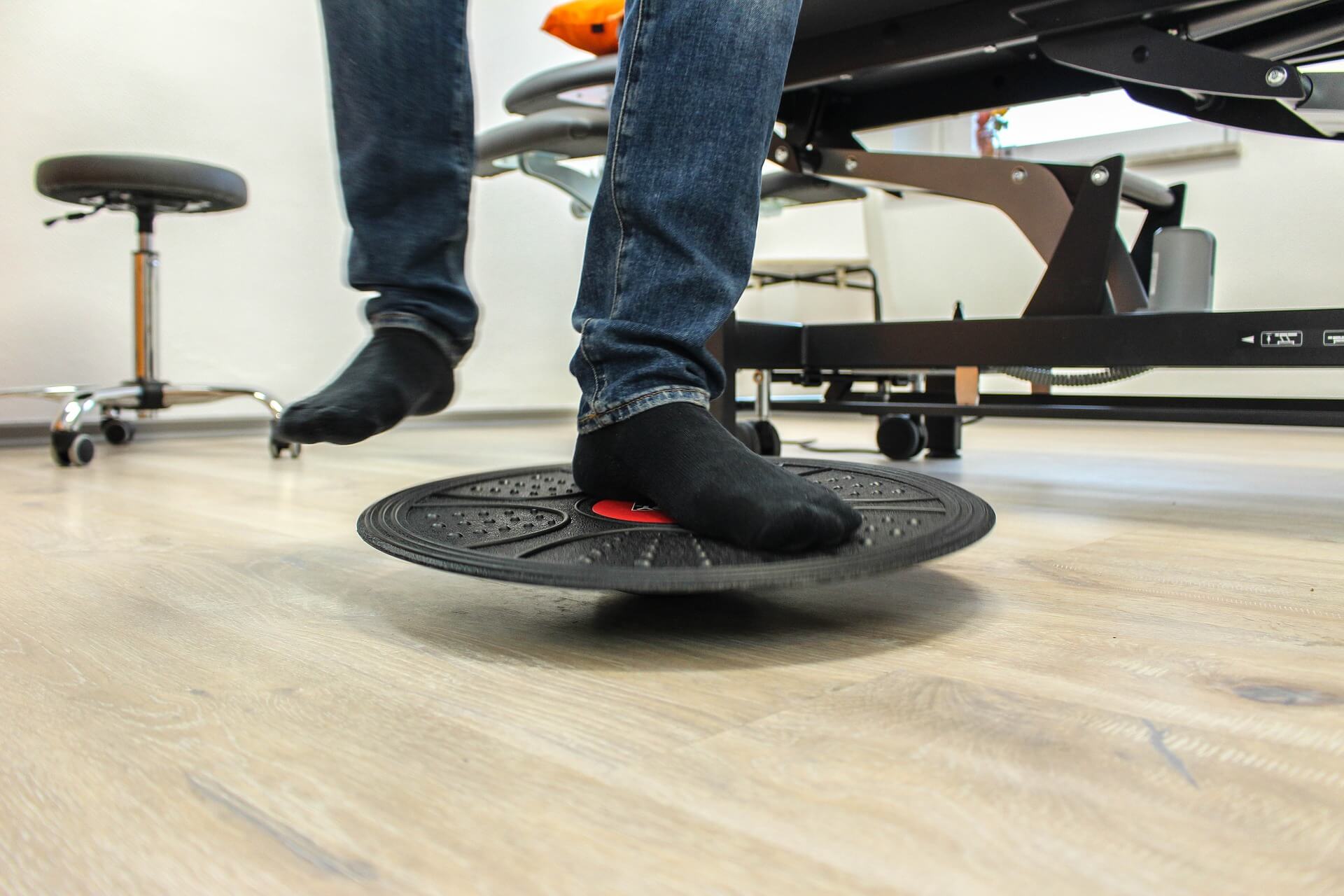What are Weak Ankles and What to do About Them

For those runners with weak ankles, an ankle sprain can be just a footstep away. But what are “weak” ankles and how do you come by them? Were you born with them or did something happen to make your ankles weak? And what is weak about them…bones or ligaments? And, most importantly, what can you do about them?
What are weak ankles and what causes them?
“Weak” ankles or chronic ankle instability (CAI) is, according to the American College of Foot and Ankle Surgeons, the repetitive giving out of the outside of the ankle.
The most common cause of chronic ankle instability is an ankle sprain that has not healed completely or was not rehabilitated properly. Repeated ankle sprains cause and continues the cycle of ankle instability.
When you suffer an ankle sprain, the ligaments of the joint are stretched and in worst cases, even torn. A sprained ankle can affect your ability to balance properly and unless you work to strengthen and rehabilitate the ligaments, recurrent ankle sprains may become an issue.

Additional causes of CAI include scar tissue that develops after a sprain; inflammation of the lining of the ankle joint; a tear or inflammation in a tendon of the joint; a fracture of one of the ankle bones; arthritis in the ankle; or an injury to the nerves that run through the ankle such as from a blow to the ankle or from entrapment (pinched nerves).
According to Medscape.com, approximately 23,000 people sprain their ankles on a daily basis, making it one of the most common injuries.
The Symptoms of Chronic Ankle Instability
The hallmark of CAI is a recurrent turning of the ankle, particularly when exercising or walking/running on uneven surfaces. Estimates for recurrent ankle sprains are as high as 85%.
Other symptoms include pain usually on the outside of the ankle that may hamper walking and exercise and that can be a sharp pain or a dull ache; continuous discomfort; swelling; stiffness; tenderness to the touch; or the feeling that your ankle is “wobbly” or that it might give out.
Chronic ankle instability or even just one sprain of the ankle joint can lead to deficits in postural control, a fancy way of saying bad balance. The bad balance can, in turn, lead to additional ankle sprains, which is why it is critical to rehabilitating a sprain as completely as possible.

The bad balance aspect of ankle sprains/chronic ankle stability has been known for quite some time as a Dr. M.A. Freedman researched and wrote about it in the 1960s in the Journal of Bone and Joint Surgery. His research consisted of asking patients who had suffered an ankle sprain to stand on the injured leg when it was safe to do so.
Almost universally, they wobbled until they had to put the foot of their uninjured leg down to stabilize themselves. Those who suffered ankle sprains had to put the foot of their injured leg down more quickly than did those who hadn’t had an ankle sprain. From this, he concluded that weak ankles equal poor balance.
But the lasting effects of ankle sprains may not be just stretched ligaments and bad balance. Jay Hertel, an associate professor of kinesiology at the University of Virginia and an ankle expert, explains that the role of the central nervous system, which is connected to every joint, is often overlooked even in injuries as common as ankle sprains.
In his article “How to Fix Bad Ankles,” he notes that ligaments have neural receptors that can be damaged by a sprain, thus compromising the signals that the receptors send to the brain about where and how the ankle and foot are positioned in relation to the ground. After suffering a sprain, your sense of your body’s position in space—or proprioception—often is unreliable, causing you to be less sure-footed and more susceptible to falling and re-injury.
How is chronic ankle instability diagnosed?
Although your primary care doctor can diagnose a simple ankle sprain, you might consider a visit to an orthopedist if there are complications or if you have frequent, recurrent sprains. An orthopedist is well-versed in prescribing physical therapy for the rehabilitation of ankle sprains which can be critical for a complete recovery.

How is chronic ankle instability treated?
A doctor’s visit for CAI will usually result in at least one of the following interventions but most likely will include a combination:
- An order for physical therapy to strengthen muscles, increase range of motion and joint flexibility and better the perception of your joint position (proprioception)
- A course of anti-inflammatory medication, either prescribed or over-the-counter, such as ibuprofen, to reduce swelling
- Extra support for the ankle in the form of a wrap or brace
- An injection of a steroid to decrease inflammation.
For those who have chronic ankle instability but don’t have an acute injury, the good news is that there are easy ways to strengthen your ankles at home.
One of the easiest and most effective exercises to restore balance and prevent additional ankle sprains is to stand on one leg trying not to wobble, hold as long as you can or up to a minute. Then repeat. Published studies have shown that this simple exercise can go a long way to restoring the ankle joint and its damaged neural receptors back to normal.

Once you can hold for a minute on the weak ankle, you can increase the intensity of the exercise by holding for more than a minute, doing it with your eyes closed, or standing on a pillow, Bosu balance trainer or balance board to increase the instability and force your ankle to work harder.
Some additional exercises include:
- Drawing the alphabet: Flex your foot and with your toes, draw the alphabet in the air. Do one time with each foot, one time per day.
- Standing calf raises: Stand on the edge of a step, holding onto the banister or a wall for balance. Lift yourself as high on your toes as possible and then drop your heels below the level of the step. Repeat ten times, once per day.
- Ankle circles: Sitting in a chair extend one leg, keeping your knee as straight as possible. Rotate your ankle clockwise 10 to 20 times. Rest for five seconds. Return leg to starting position and rotate ankle counterclockwise 10 to 20 times. Alternate legs and complete three to four sets per side per day.
- Heel walks: Balancing on the heels of both feet, walk across the floor on your heels.
One ankle sprain does not have to be the beginning of chronic ankle instability. Be careful to rehabilitate your weak ankle completely in accordance with your doctor’s orders. And once you are able, incorporate ankle strengthening exercises and balance training to ward off any recurrent sprains.
Sources
- , Weak ankles? Seven easy exercises that will save you from rolling them again, web site
- , How to Fix Bad Ankles, web site
- , Stop Sprains: 3 Easy Exercises for Your Weak Ankles, web site
- , Your 5-Step Cure for Bad Ankles, web site
Latest Articles
 Is Running on a Treadmill Easier Than Running Outside?Runners have their own preferences, whether it is treadmill running, running outside on the road, or exploring trails. So...
Is Running on a Treadmill Easier Than Running Outside?Runners have their own preferences, whether it is treadmill running, running outside on the road, or exploring trails. So... Is It OK to Use Trail Running Shoes on the Road?While trail running shoes can be used on roads, especially in situations where a runner encounters mixed terrains or pref...
Is It OK to Use Trail Running Shoes on the Road?While trail running shoes can be used on roads, especially in situations where a runner encounters mixed terrains or pref... How to Fix Sore Quads After Running?Rest, ice, gentle stretching, and over-the-counter pain relievers can help soothe sore quads after running. Also, ensure ...
How to Fix Sore Quads After Running?Rest, ice, gentle stretching, and over-the-counter pain relievers can help soothe sore quads after running. Also, ensure ... 10 Fruits With The Most Electrolytes to Replace Sports DrinksThese fruits are high in electrolytes such as potassium, magnesium, and calcium, essential for hydration, muscle function...
10 Fruits With The Most Electrolytes to Replace Sports DrinksThese fruits are high in electrolytes such as potassium, magnesium, and calcium, essential for hydration, muscle function...

